 This page has been mothballed.
This page has been mothballed.
It is no longer being updated but we've left it here for reference.
 HillPlan Examples
HillPlan Examples
A HEATHER HILLAn example of the output from HillPlan is shown in Figure 2 for a hillside with 70% dry heather (predominantly Calluna) with 20% of Bent/Fescue pasture (Festuca/Agrostis) and an area of blanket bog on the hill top (10%). |
||||||
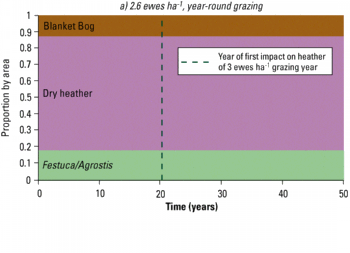 HillPlan predicts that with year-round stocking with sheep is compatible with retention of heather cover if an appropriate stocking rate (2.6 ewes per hectare or approximately 1 ewe per acre) is used (Figure 2a). HillPlan predicts that with year-round stocking with sheep is compatible with retention of heather cover if an appropriate stocking rate (2.6 ewes per hectare or approximately 1 ewe per acre) is used (Figure 2a). |
||||||
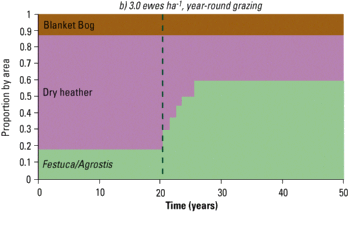 Increasing the stocking rate to 3 ewes per hectare year-round, reduces heather cover dramatically after 20 years (Figure 2b). Increasing the stocking rate to 3 ewes per hectare year-round, reduces heather cover dramatically after 20 years (Figure 2b). |
||||||
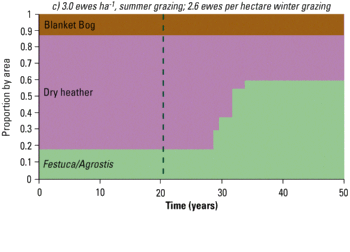 However, retaining 3 ewes per hectare in summer and reducing winter stocking rate to 2.6 ewes per hectare delays the onset of heather loss to around year 27 (Figure 2c). However, retaining 3 ewes per hectare in summer and reducing winter stocking rate to 2.6 ewes per hectare delays the onset of heather loss to around year 27 (Figure 2c). |
||||||
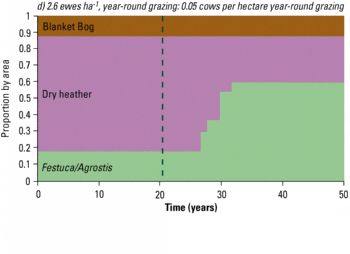 Stocking year-round with the equivalent total biomass of sheep at 3 ewes per hectare using cattle (0.05 ewes per hectare, 10% of total biomass) and sheep (2.6 ewes per hectare, 90% of total biomass) delays the onset of heather loss until around year 25 (Figure 2d). Stocking year-round with the equivalent total biomass of sheep at 3 ewes per hectare using cattle (0.05 ewes per hectare, 10% of total biomass) and sheep (2.6 ewes per hectare, 90% of total biomass) delays the onset of heather loss until around year 25 (Figure 2d). |
||||||
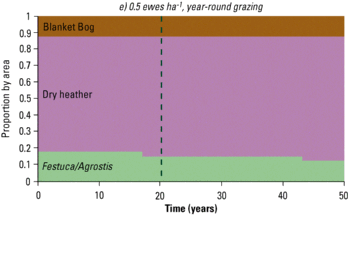 Changing the year-round grazing balance to 20% cattle (0.1 cows per hectare) and 80% sheep (2.4 ewes per hectare) sustains heather cover at its starting level. Heather cover can be extended in the long run by reducing year-round stocking rate to 0.5 ewes per hectare (Figure 2e). In all of these examples, the blanket bog remains unaffected. Changing the year-round grazing balance to 20% cattle (0.1 cows per hectare) and 80% sheep (2.4 ewes per hectare) sustains heather cover at its starting level. Heather cover can be extended in the long run by reducing year-round stocking rate to 0.5 ewes per hectare (Figure 2e). In all of these examples, the blanket bog remains unaffected.
Results from a range of options as shown in this example can be used to decide upon the most appropriate grazing scheme for the hillside to achieve the desired vegetation balance. |
||||||
A GRASSY HILL |
||||||
|
||||||
The arthropods form part of a complex food web and will contribute to a generally higher level of biodiversity despite the fact that there will be little change in the botanical composition of these grassy hills. Contact: Jim McLeod A copy of this information has been supplied in Adobe Acrobat format, please ensure that you have the Acrobat reader installed to view this file. Acrobat reader can be downloaded from here. |
||||||


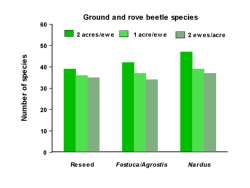 This example is based on a "typical" grassy Borders hill unit consisting of 60% Matt Grass rough pasture (predominantly Nardus), 35% Bent/Fescue pasture (Festuca/Agrostis) and 5% reseed. An "average", year-round stocking rate of 2.5 ewe per hectare (1 ewe per acre) was compared with a reduced stocking rate of 1.25 ewes per acre and an increased stocking rate of 5 ewes per acre.
This example is based on a "typical" grassy Borders hill unit consisting of 60% Matt Grass rough pasture (predominantly Nardus), 35% Bent/Fescue pasture (Festuca/Agrostis) and 5% reseed. An "average", year-round stocking rate of 2.5 ewe per hectare (1 ewe per acre) was compared with a reduced stocking rate of 1.25 ewes per acre and an increased stocking rate of 5 ewes per acre.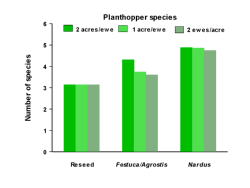 HillPlan forecast that, over a 10-year period, the botanical composition of the hill unit would not change under the "average" or the lowest stocking rate, However, the lowest stocking rate would result in a much greater proportion of tussock and less closely-grazed "lawn" in the Bent/Fescue pasture, in the Matt Grass rough pasture and in the reseed, resulting from the lower grazing pressure.
HillPlan forecast that, over a 10-year period, the botanical composition of the hill unit would not change under the "average" or the lowest stocking rate, However, the lowest stocking rate would result in a much greater proportion of tussock and less closely-grazed "lawn" in the Bent/Fescue pasture, in the Matt Grass rough pasture and in the reseed, resulting from the lower grazing pressure.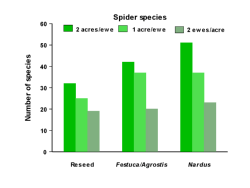 HillPlan forecast that, after 10 years under the greater grazing pressure of the highest stocking rate, the Bent/Fescue pasture would spread into the area of Matt Grass Rough pasture and there would be a much higher proportion of closely-grazed "lawn" areas with much less tussock in all three pasture types.
HillPlan forecast that, after 10 years under the greater grazing pressure of the highest stocking rate, the Bent/Fescue pasture would spread into the area of Matt Grass Rough pasture and there would be a much higher proportion of closely-grazed "lawn" areas with much less tussock in all three pasture types.